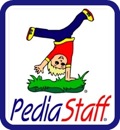Crossing the midline.
That’s a goal (or objective) frequently used in music therapy sessions. I have used it for children with autism, children with developmental disabilities, and for trauma-influenced children. It also seems to be a common therapeutic goal for occupational therapists.
A Sample Intervention
There’s an intervention I use in my weekly sessions with trauma-influenced kids. I borrowed it from a music therapist who works exclusively with children on the spectrum (e.g. children with autism). I (very clever ly) call it the “Right-Left Song“:
ly) call it the “Right-Left Song“:
Right and left and right and left Susie’s playing the drum
She’s going right and left and right and left she’s playing the drum. (Repeat)
As I sing, Susie uses mallets to play two drums, alternating using her right hand to play the drum on the left side of her body and her left hand to play the drum on the right side of her body. All in time to the music. It’s a crossing the midline experience, but it also integrates auditory, visual, and proprioceptive sensory information. I’ve also found this particular intervention to be a great assessment tool. I can tell on any given day if a child is feeling calm and regulated or stressed and dysregulated. It’s also easy for me to “assess” a new child, to know generally where this child is developmentally.
Importance of Crossing the Midline
But I digress. My real question is: What’s the big deal about crossing the midline? Why is this such an important skill to develop? Between my own experiences (and some quick Google searches), here is what I’ve found:
- My infant daughter just had her 6 month well visit appointment. Prior to this appointment, her pediatrician asked me to fill out an assessment tool to make sure she is meeting her developmental goals. What was one of the goals this month? Crossing her midline. Reaching across her body to pick up a toy on the opposite side (and, yes, she passed).
- Crossing the midline is an indicator of bilaterial coordination, meaning the “ability to use both sides of the body at the same time.” This is an important skill for many of our daily tasks: climbing stairs, walking, typing on a computer (Yay! I can cross my midline), riding a bicycle, picking up our children, catching a beach ball, climbing ladders, etc.
- The development of bilateral coordination is also important for the development of cognitive skills, such as the ability to read, write, and learn. Both skills utilize both hemispheres of our brain. Crossing the midline, a skills devloped in infancy, may be an important precursor to a child’s ability to learn.
- Here is a good article about the relationship between dominance and crossing the midline. The author says that the ability to cross our midline is a “prerequisite for appropriate lateralisation.” Most people have one hemisphere that is more dominant (e.g. lateralised) than the other (You may have heard people referred to as “right brained” or “left brained”; although not entirely wrong, this is a grossly simplified generalization). If lateralisation is not established, a person may have difficulties in various areas: making decisions, organizing, fine and gross motor organization, writing, reading, and language development, among others.
So it seems that crossing the midline is an important, basic prerequisite skill required for the appropriate development of various motor and cognitive skills. To me it seems akin to developing sustained attention or developing the ability to self-regulate (future posts, perhaps?). Both are basic, prerequisite skills needed for other learning and development to take place.
So I have learned something new; it now makes sense to me why we so often work on crossing the midline in our music therapy sessions.
And I’m glad my trauma-influenced clients like the “Right-Left Song” – we’ll be doing it for awhile!


 orcid.org/0000-0001-8665-1493
orcid.org/0000-0001-8665-1493






{ 17 comments… read them below or add one }
Kimberly! Thank you so much for this post – I have a client with Down’s Syndrome who has difficulties crossing the midline. I, too, use a hand drum & a mallet and have him track the drum while moving it slowly from left to right. With one hand, he will play the drum all the way from one side to the other but with the other hand, he’ll get to midline and switch hands. Very interesting! I’m going to use your activity and continue to work on it.
That is interesting. And it sounds like it’s a goal to continue working on with you client. If you would like to hear the song, email me and I will get it to you. Good luck!
Amazing, I didn’t heard about that till now. Thankz.
It’s kinda cool, isn’t it? Have a great weekend!
Kimberly
Your blog is very interesting. I have a couple questions. I saw your intervention with trauma- influenced children. It was the one with the paddle drums alternating right and left but i dont remember the tune. Would you be willing to share? I’m doing something very similar to that but using preferred music in 3/4 and 4/4 and it is difficult to keep the clients playing on the beat even though I’m tapping my leg with the paddle drum the is not the target? ANy suggestions? Also I was looking through some old text looking for the actual definition of crossing midline. If a person can only pass midline by an inch or two is this enough to say someone crossed midline?Thanks for the cool blog!
Jeremy-Thanks for your comment! I know exactly what you’re talking about. I will try to get that song posted within the next couple weeks. I’ve been meaning to for a while…but just haven’t gotten around to it, yet. As for your question, yes! It’s my understanding that even “meeting in the middle” (e.g. clapping hands) is crossing the midline. ~Kimberly
I’m not a music therapists, but I teach Kindermusik. We “cross the midline” in every lesson for babies! I enjoyed your article and will share it with my families. Thanks so much!
Yes! It’s SUCH an important developmental step to learn and practice. ~Kimberly
there is still no permament solution for autism. we just have to take good care of the kids who are suffering autism.::,
there has been no permanent cure for autism yet but i think stem cells could also help–*
Great information! Could you give some examples of short term goals (activities) for working on crossing the midline with children under 3? Thanks
i have a brother that is autistic and we love him so much and gave all of our support on him ::-
What an awesome post Kimberly! I am going to share this with my MT classmates 🙂
Good day , I have a son of twelve that seem to have a problem with mid line crossing . Do you know of any exersizes for older children . Tx Magda .
Magda – I would recommend you connect with an occupational therapist in your area. He/She should be able to provide you with specific exercise to help your son. Find one here: http://www.aota.org/ Good luck! ~Kimberly
Nice blog! Is your theme custom made or did you download
it from somewhere? A design like yours with a few simple
tweeks would really make my blog jump out.
Please let me know where you got your design. Thank you
I used the Thesis theme for Wordpress. Good luck! ~Kimberly
You must log in to post a comment.
{ 8 trackbacks }